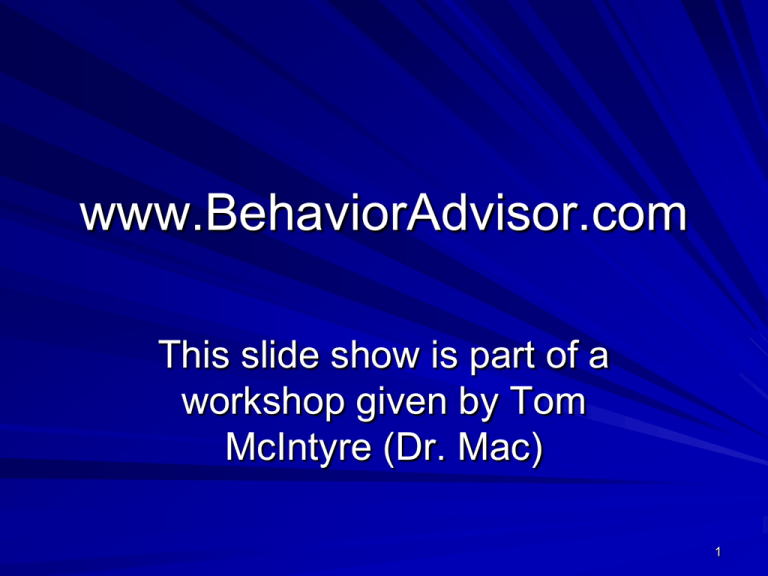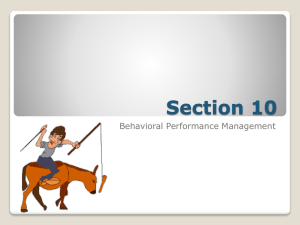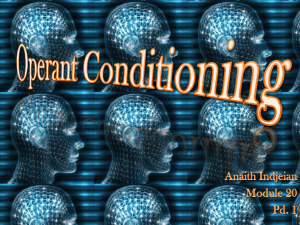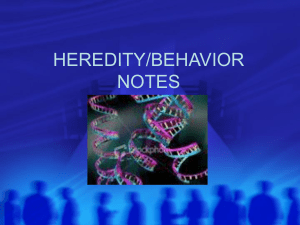Behavioral Recording
advertisement

www.BehaviorAdvisor.com This slide show is part of a workshop given by Tom McIntyre (Dr. Mac) 1 OPERANT BEHAVIOR: An Introduction to ABA Tom McIntyre, Ph.D. www.BehaviorAdvisor.com Your “Do Now” Activity… Cute cartoon. Can you decipher the humor? Many slides have been adapted from a slideshow by Dr. Rosa Martinez 2 Behaviorist Categories Of Behavior RESPONDENT Unlearned actions that are elicited by “antecedent stimuli” OPERANT Acquired actions that are evoked by learned antecedentbehaviorconsequence strings (The A-B-C paradigm) 3 Crying: Respondent or Operant? 4 Respondent or Operant? 5 Respondent Behavior & “Conditioning” of New Behaviors In the presence of an “antecedent stimuli”, a response occurs In other words… “Something causes a naturally occurring reaction.” (“Unconditioned” behavior… no “conditioning” or training needed) What are some naturally occurring, “un-conditioned” behaviors? – Salivate at the smell (or even the thought) of food – Fall asleep when tired – Jump at loud sound 6 Who was the major figure associated with respondent behavior being “conditioned” (trained ) to appear under other circumstances? (The “Classical” School of Behaviorism) Ivan Petrovich Pavlov 7 Does the Name “Pavlov” Ring a Bell? What do you remember about Dr. Pavlov? 8 9 10 Hey! Who’s doing the conditioning here? 11 What if Pavlov Worked with Cats? 12 Old School In “classical conditioning” there is a – Strong machine-like connection – A “fizzy” (Alka-seltzer) response Between a – Happening (“stimulus”), and – The behavior that follows (“response”) These connections can be – Naturally occurring – Trained (“conditioned”) Bag/Balloon 13 Fido welcomes you back to the homestead ~ Blow in eyes ------- Dog blinks (Reason?) Thumb nose ------- Dog blinks (Reason?) Which is the: – Unconditioned stimulus? – Unconditioned response? – Conditioned stimulus? – Conditioned response? 14 Albert & The White Lab Rat Any recollection of this “experiment” from “Psych 101”? 15 Adding a Letter to the Behaviorist Alphabet The “classical” school of behaviorists was familiar with the “A” & the “B”. Operant folks added the “C”. ANTECEDENT BEHAVIOR CONSEQUENCE 16 Operant Conditioning An Antecedent spurs a Behavior to occur. Whether the behavior occurs again in the future will depend on the Consequence that follows the action. In other words: In recurring situations (Antecedent), we keep doing the same things (Behavior) because it has brought benefits (Consequences) during those times. We don’t show other behaviors because they didn’t bring benefits in those situations, OR we don’t see new actions as bringing any more benefits than the action that is working for us right now. 17 “I don’t want any stupid milk!” Possible… Antecedent: __________ ________________ Behavior: _____________ ________________ Consequence: __________ ________________ 18 Operator, can you tell me the name of the prominent figure in this “newer” school of Behaviorism? Hint. Hint… 19 Burrhus Frederick Skinner 1904-1990 20 Who was B.F. Skinner? 21 The Behavior Of Organisms (Skinner, 1938) Provided a model & descriptive analysis of how mammals learn. Premise? The environment teaches us. We learn from the consequences that follow our actions. There are 3 “teachers” (5 if counting sub-types) 22 The “Teachers”: Consequences Positive Reinforcement – Showing a behavior results in a “reward” (Something desirable occurs) Negative Reinforcement – Demonstration of a behavior removes or avoids an “aversive stimulus” (Something undesirable never happens OR goes away) Positive Punishment – An exhibited behavior results in the appearance of an aversive stimulus (Something undesirable happens to the person) Negative Punishment – Showing an action results in the removal of positive stimulus (Something desirable is taken away) Extinction – The disappearance of a behavior due to lack of reinforcement (“Ignoring”) 23 Press 2 for ABA Skinner did not work with humans (except for his daughter). Applied behavior analysis developed from the experiments and ideology of operant conditioning with animals. ABA focuses on another mammal… humans. 24 What is Applied Behavior Analysis? (Cooper, Heron, & Heward, 1987) Applied behavior analysis is the science in which procedures derived from the principles of learning are systematically applied to improve socially significant behavior & to demonstrate experimentally that the procedures used were responsible for the improvement in behavior. 25 Skinner’s Theory “All we need to know in order to describe and explain behavior is this: Actions followed by good outcomes are likely to recur, and actions followed by bad outcomes are less likely to recur.” (Skinner, 1953) Simplistic, but profound. 26 A Closer Look at “The Teachers” First up: Punishment 27 It’s gonna hurt me more than you… 2 types of punishment – Positive (receives an undesirable response) – Examples of “Giving it to ‘em”? – Negative (something desirable is taken away) – Examples of “You just lost…”? 28 Which problems accompany the use of punishment? Emotional or physical harm can result. The kids fear you. The kids come to dislike you. The kids think that you don’t like them. The punishment may not outweigh the rewards of the behavior. The kids avoid you or just learn to be sneakier so they don’t get caught. The “punishment” might actually be a reinforcer. Punishment does not teach better behaviors, so the same one keeps popping up. For example… 29 “To a man with a hammer, everything looks like a nail.” Mark Twain 30 Are we really “Teaching him a lesson.”? Dr. Mac: “…and what do you do when Tony shows that behavior?” Parent: “I come up on him and give him a lickin’ (spanking) right quick.” Dr. Mac: “Maybe we can come up with another way that you might deal with the behavior.” Parent: “What for? It works. I give him the palm of my hand; he stops.” Dr. Mac: “How often do you spank Tony?” Parent: “Sh-- man… Sometimes 3… 4 times a day. Sometimes my damn hand is bruised come the end of the day.” 31 I’m ignoring you. Really, I am! Do you hear me?! I’m ignoring you! Ignoring to Extinction (Is this how the dinosaurs died?) What do behaviorists mean by “ignoring”? What are they doing when they ignore? – Withholding reinforcement – Keeping the action from receiving its usual dose of reward 32 What problems often occur when ignoring a behavior? Hard to ignore some behaviors Will you ignore the hitting of another? Expect a “Behavior Burst” (escalation of a behavior) You get the kids to ignore too (for a reinforcer), but a colleague who is unaware of the implementation of the strategy leans in the door and tells the kid to stop. 33 Real men reinforce things with duck tape 2 types of reinforcement. They are…? – Positive (receipt of something desirable for an action) – Negative – Most people understand “positive reinforcement”… – But what is “negative reinforcement”? (If you say it’s the same as punishment, you fail the course) – One’s action results in something negative going away never happening – Other ways to explain it: It feels good not to be punished You “dodged the bullet” 34 Clickers A student receives 2 nights of detention for refusing teacher directions and uttering rude comments. This example is one of: 1. Positive punishment 2. Negative punishment 3. Negative reinforcement 35 The student who received the 2 nights of detention disliked it intensely. It was embarrassing, she missed her social connections after school, and got in trouble with her parents. Thence forth, she complied with directions and used respectful language toward the teacher, even when she did not wish to do so. Her actions are a result of: 1. Positive punishment 2. Negative punishment 3. Negative reinforcement 4. Positive reinforcement 36 A student receives a sticker for each homework submitted. The student’s homework submission percentage increases. The motivator was: 1. Positive punishment 2. Positive reinforcement 3. Negative reinforcement 4. A combination of the 2 types of reinforcement 37 A student engages in fight and is sent to the principal’s office. The teacher intends this disciplinary action to serve as: 1. Positive punishment 2. Negative punishment 3. Negative reinforcement 38 A student is being poked. He dislikes this physical contact, but fails to issue any sort of “cease and desist” action or verbiage. Which of his behaviors is being punished? How might negative reinforcement be involved here? (Avoiding a worse punishment) 39 The student being poked moves her chair out of reach of the prodding finger. Her scooching (moving away) action is: 1. Positively punished 2. Negatively punished 3. Positively reinforced 4. Negatively reinforced 5. An example of ignoring the student who did the poking 40 Over the course of a couple of minutes, a student’s inappropriate behavior escalates. The behavior is probably being: 1. Positively reinforced 2. Negatively reinforced 3. Ignored 4. Punished 5. It depends on the situation. We need more information to determine the answer. 41 The teacher reacts to spitting by having the student research the topic and write an essay about why the expectoration behavior was inappropriate. This disciplinary action is intended by the teacher to be: 1. Positive punishment 2. Negative punishment 3. Negative reinforcement 4. “Busy work” 42 After being belittled by the teacher for offering an incorrect oral answer to her question, Ricky fails to contribute any more commentary. His silent behavior is maintained by: 1. Positive punishment 2. Negative punishment 3. Negative reinforcement 4. Positive reinforcement 43 A youngster seems to “set himself up” repeatedly to be victimized by the bully. His seemingly masochistic behavior is maintained by: 1. Positive punishment 2. Negative punishment 3. Positive reinforcement 4. Negative reinforcement 5. Mental health issues 44 A teacher approaches a child and puts his arm around the youngster’s shoulder. The crying, caused by embarrassment, quickly stops. The crying behavior responded to: 1. Positive reinforcement 2. Negative reinforcement 3. Ignoring 4. Positive punishment 5. Negative punishment 6. ABA can’t explain it 45 46 Activity: 10 Levels of Reinforcement Groups: When you receive the document, convene to add at least one more reinforcer to each level. Begin with level 10 and move up to level 6. Stop there. After our class discussion, you will reconvene to add one more reinforcer to each of levels 5 to 1. 47 SCHEDULES OF REINFORCEMENT (accompanies document & discussion) Interval schedules - reinforcement given after a certain amount of time has passed Fixed Interval - reinforcement is presented after a fixed (always the same) amount of time expires Variable Interval - reinforcement is delivered on a random (unpredictable to all) OR variable time schedule (unpredictable to the student) Ratio schedules - reinforcement given after a certain number of responses have been emitted Fixed Ratio - reinforcement is presented after each completion of a designated # of responses (always the same number) Variable Ratio - reinforcement delivery is variable, but based on an overall average number of responses 48 Variable Schedule Interval (VI5) or Ratio (VR5) + + + + + 49 Which Schedule? Julio is reinforced each time that he withholds curse words for the entire class period. 1. Continuous ratio 2. Continuous interval 3. Fixed ratio 4. Fixed interval 5. Variable ratio 6. Variable interval 50 Which Schedule? Louise is reinforced for every 3rd recess period during which she exhibits only “friendly” behavior. 1. Continuous ratio 2. Continuous interval 3. Fixed ratio 4. Fixed interval 5. Variable ratio 6. Variable interval 51 Which Schedule? Emma is reinforced each time she says “Excuse me.” when interrupting a conversation. 1. Continuous ratio 2. Continuous interval 3. Fixed ratio 4. Fixed interval 5. Variable ratio 6. Variable interval 52 Which Schedule? Joe is reinforced for every 5th homework assignment submitted. 1. Continuous ratio 2. Continuous interval 3. Fixed ratio 4. Fixed interval 5. Variable ratio 6. Variable interval 53 Which Schedule? Students trying out for roles in the school plays 1. Continous ratio 2. Continuous interval 3. Fixed ratio 4. Fixed interval 5. Variable ratio 6. Variable interval 54 Which Schedule? “News” story about man asking ladies to join him for coffee. 1. Continous ratio 2. Continuous interval 3. Fixed ratio 4. Fixed interval 5. Variable ratio 6. Variable interval 55 Which schedule? Every 4th 10-minute time period that Sigmund has displayed “hands-to self” behavior, he gets a point (toward the 20 points he must earn for a video he has requested as his prize). 1. Continous ratio 2. Continuous interval 3. Fixed ratio 4. Fixed interval 5. Variable ratio 6. Variable interval 56 Can ABA be Explained by ABA? Can ABA explain all of our behavior patterns and situational responses? Do emotions come into play? How would ABA explain impulsive acts (Due to emotion or ADHD)? Do our emotions develop from how the environment acts upon us? ABA is essential for working with young, severely impaired kids. What do you do when kids outgrow ABA practices & younger kids with conduct disorders laugh at your tokens and contracts? 57





